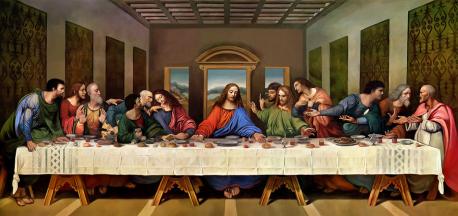Results: The Last Supper
Published on 03/26/2017
QUESTIONS
GO to COMMENTS
Comments
1.
1.
The Last Supper or L'Ultima Cena is a late 15th-century mural painting by Leonardo da Vinci in the refectory of the Convent of Santa Maria delle Grazie, Milan. It is one of the world's most famous paintings. The work is presumed to have been commenced around 1495-1496 and was commissioned as part of a plan of renovations to the church and its convent buildings by Leonardo's patron Ludovico Sforza, Duke of Milan. The painting represents the scene of The Last Supper of Jesus with his disciples, as it is told in the Gospel of John, 13:21. Leonardo has depicted the consternation that occurred among the Twelve Disciples when Jesus announced that one of them would betray him. Due to the methods used, and a variety of environmental factors, as well as intentional damage, very little of the original painting remains today, despite numerous restoration attempts, the last being completed in 1999. What say you about this painting?

I've heard of the painting
54%
784 votes
I've seen it before
39%
563 votes
I have been to the church in Italy
4%
56 votes
N/A
17%
243 votes
2.
2.
The last supper took place on the first day of Passover, or the Festival of Unleavened Bread. Jesus sent his disciples ahead into the city to prepare a meal to celebrate Passover. Passover is the remembrance of Israel being freed from slavery to Egypt and specifically when the angel of death passed over the homes of the Israelites that had lambs blood over the doors. As the disciples reclined and ate dinner with Jesus, he explained to them that one of the twelve of them would soon betray him. One by one the disciplines denied that it would be them, including Judas who would be the betrayer. Jesus responded that the person who betrays him will have a terrible fate and that indeed, it was Judas. Jesus prayed and thanked God for the meal. He then broke the bread and shared the wine with the disciples and explained to them how the bread was a symbol of his body, broken for them, and the wine a symbol of his blood which would be poured out for their sins to be forgiven. This is where the churches tradition of communion comes from. After the meal, Jesus became like a servant and washed the feet of the disciples. Peter did not feel right having Jesus wash his feet but Jesus said that He was doing it to be an example to them. Now the disciples would be able to wash each others feet, meaning they could be servants to all. If you are familiar with the meaning of the painting, does this explanation sound similar to what you know? Very close or exactly
45%
653 votes
Somewhat close, I learned it differently
18%
269 votes
Very different to what I know
5%
73 votes
N/A
32%
465 votes
3.
3.
Here are some other things related to The Last Supper painting. Check off the ones that you know: A 16th-century oil on canvas copy is conserved in the abbey of Tongerlo, Antwerp, Belgium. It reveals many details that are no longer visible on the original.
7%
103 votes
In 1955, Salvador Dalí painted The Sacrament of the Last Supper, with Jesus portrayed as blond and clean shaven, pointing upward to a spectral torso while the apostles are gathered around the table heads bowed so that none may be identified. It is reputed to be one of the most popular paintings in the collection of the National Gallery of Art in Washington, D.C.
10%
139 votes
In 1986, Andy Warhol was commissioned to produce a series of paintings based on The Last Supper that were exhibited initially in Milan. This was his last series of paintings before his death.
6%
94 votes
Sculptor Marisol Escobar rendered The Last Supper as a life-sized, three-dimensional, sculptural assemblage using painted and drawn wood, plywood, brownstone, plaster, and aluminum. This work, Self-Portrait Looking at The Last Supper, (1982–84) is in New York's Metropolitan Museum of Art.
4%
64 votes
In 2001, Chinese artist Zeng Fanzhi painted Last Supper, showing 13 mask-wearing people seated at a table strewn with watermelon fragments. The oil painting was sold for $23.3 million at Sotheby's auction on October 7, 2013, setting a new record for contemporary Asian artwork.
3%
47 votes
In 1998, modern artist Vik Muniz displayed a recreation of The Last Supper, made entirely out of Bosco Chocolate Syrup.
3%
43 votes
Author Mary Shelley describes her impression of the painting in her travel narrative, Rambles in Germany and Italy published in 1844: First we visited the fading inimitable fresco of Leonardo da Vinci. How vain are copies! not in one, nor in any print, did i ever see the slightest approach to the expression in our Savior's face, such as it is in the original. Majesty and love — these are the words that would describe it — joined to an absence of all guile that expresses the divine nature more visibly than I ever saw it in any other picture.
4%
59 votes
In Luis Buñuel's Spanish film Viridiana, a tableau vivant of Leonardo's painting is staged with beggars. Another beggar 'photographs' the scene by flashing them. This scene contributed to its refusal by the Vatican who called it "blasphemous."
3%
37 votes
The painting is parodied in Mel Brooks's movie History of the World, Part I, making Leonardo a contemporary of Jesus.
8%
122 votes
N/A
74%
1082 votes
4.
4.
Additionally, here are some speculations regarding the painting. You might find them interesting. Check off the ones that you have heard already: The Last Supper has been the target of much speculation by writers and historical revisionists alike, usually centered on purported hidden messages or hints found within the painting, notably since the publication of the novel The Da Vinci Code by Dan Brown in 2003.
24%
348 votes
Dan Brown proposed that the person to Jesus' right (left of Jesus from the viewer's perspective), was not John the Apostle, but Mary Magdalene. This speculation was copied from earlier books The Templar Revelation (1997) by Lynn Picknett and The Holy Blood and the Holy Grail by Michael Baigent, Henry Lincoln and Richard Leigh (1982). These claims have been contested by other writers, such as Carl E. Olsen and Sandra Miesel in The Da Vinci Hoax, as well as by art historians. Christopher Hodapp and Alice Von Kannon commented "If he [John] looks effeminate and needs a haircut, so does James, the second figure on the left, the one with the sort of Bette Midler look about him"
23%
331 votes
Giovanni Maria Pala, an Italian musician, has indicated that the positions of hands and loaves of bread can be interpreted as notes on a musical staff and, if read from right to left, as was characteristic of Leonardo's writing, form a musical composition.
5%
77 votes
N/A
64%
941 votes
5.
5.
Finally do you have or did you growing up, a picture of the Last Supper in your residence? Had one growing up
18%
259 votes
Had or currently have one
9%
132 votes
Both
6%
85 votes
Neither
67%
984 votes
COMMENTS


